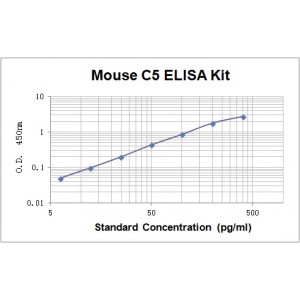More info
Assay Range | 6.25 - 400 pg/mL |
Sensitivity | 1.5 pg/mL |
Specificity | No cross-reaction with other related substances detected |
Size | 96T |
Storage | Store at 2 - 8ºC. Keep reconstituted standard and detection Ab at -20 ºC |
Assay Principle | Sandwich ELISA |
Sample Volume | 100 µL final volume, dilution factor varies on samples |
Detection Method | Chromogenic |
Kit Components
1. Recombinant Human C5 standard: 1 vial
2. One 96-well plate coated with Human C5 Ab
3. Sample diluent buffer: 12 mL - 1
4. Biotinylated Detection antibody: 2 vials
5. Streptavidin-HRP: 200 µl
6. TMB developing agent: 12 mL x1
7. Stop solution: 8 mL x1
8. Washing solution (20x): 25 mL x1
Background
The component 5 (C5) in the complement pathway of immune system is a naturally glycosylated (1.6%) polypeptide containing two disulfide-linked chains. C5 is essential for formation of the membrane attack complex (MAC) and is activated by all three pathways of complement activation. Each pathway of complement activation generates proteolytic enzyme complexes (C3/C5 convertases), which are bound to the target surface. These enzymes cleave a peptide bond in the larger alpha chain of C5 releasing the highly potent anaphylatoxin C5a (74 amino acids) and activating C5b. The potent pro-inflammatory anaphylatoxin C5a binds to receptors C5aR and C5L2 to initiate acute inflammatory responses. The C5a-mediated early pro-inflammatory responses include sepsis, systemic lupus erythamatosis and cerebral malaria. The C5b interacts with complement components C6, C7, C8, and C9 to form a membrane attack complex C5b-9 which is involved in cell apoptosis, cell activation and production of proinflammatory mediators. C5 deficiency is associated with severe infantile dermatitis Leiner's disease.


